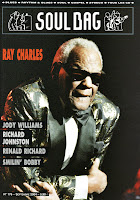They recently unleashed an even bigger surprise: a crude 9m22s video that was recorded of the same concert over the Fillmore West's in-house tv-system. The release is part of a new program where Wolfgang's Vault will digitize and publish hundreds of hours of historical concert video tapings.
Every fan can no doubt live with the very limited quality of the video and the audio. The discrepancy between the concert as I have always visualized it in my mind and these actual pictures is huge. The stage is even smaller, and much more cramped, than I thought, and the response of the audience seems to have been much more laid back than Wexler's edit suggested. But that's just a reality check.
A bit harder to swallow is that the footage does not include the golden moments where Aretha interrupted her own rendition of Spirit to bring Ray on stage, happily shouting "I discovered Ray Charles".
Since those were the moments that always raised my neck hair and always gave me goosebumps when I listened to the original album version. Those were the moments that became part of my life's sound track.
By the way, I'm not sure if this footage actually is completely lost. As I wrote in an early post, the BBC archive's description of the Omnibus documentary Aretha Franklin - Queen Of Soul (1987) promises 168 seconds where we see how "Aretha brings Ray Charles onto stage & they sing Spirit in the Dark". And I still have a few more trails to follow to other footage.
Update 18 May 2012:
A friend send me a complete 25-minute copy of the in-house video with Ray's contribution to the show, entirely congruent with the unabridged audio copy mentioned above.
This is what really happened: after performing Spirit In The Dark as her solo concert's finale, Aretha leaves the stage (at 5:05), obviously preparing to come back for an encore. When she returns (at 6:15), Ray is at her side. After bringing him to center stage, she sits down behind the electric piano, and leaves Ray standing beside her to do his thing (from 7:20). Ray then delivers his first eight minutes standing up (only time I have ever seen him doing that in a live concert!). 15 minutes into the tape, Ray takes over the piano - and this is where the Wolgang's Vault video (linked above) starts.
Update 19 May 2012:
The unabridged video (the only omission is Ray's walk-off) is also on Youtube!












